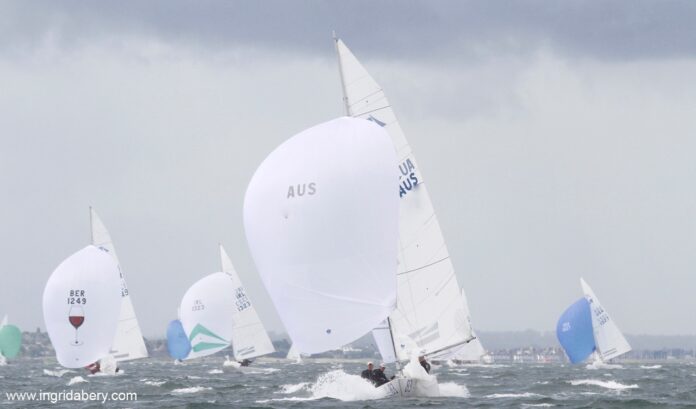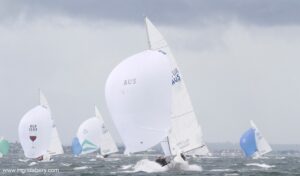

Wind, Weather and Currents – Part 3. Continuing Andrew Palfrey’s insights regarding working with the weather to improve your racing.
Brett: If a wind shift seem persistent, how do you establish a mean or is it a constant process?
Yeah, look, just to comment on Melbourne, it’s a fantastic place to race boats, as we know, great conditions, wind, sea. But because of that steady-state nature of the breeze, when it’s blowing from the sort of southwest area, and also the lack of tides.
You come to a place of like Cowes where I live now, and it’s almost a different sport. So I think people that learn to sail in…there’s so many good sailors that come from Sydney that learn to sail up west of the Sydney Harbor bridge, for example, or Pittwater, where the breeze comes out of all the valleys, and little bays, and nooks and crannies. It’s so unstable.
FREE BOOK – TIPS FROM SAILING LEGENDS
Local Knowledge
Even Tom Slingsby is an example of that, having grown up in the Gosport area. Basically, you just become used to things not being stable and instinctively pick-up these cues of what the wind looks like on the water or even looking at the landscape geography.
Up the course, say, the wind’s coming from the land, and just sort of instinctively almost knowing that all that little hollow there, fair chance there’s going to be more breeze downwind of that, or whatever.
So this…I mean that’s just a little one off the side. I mean, what is the mean number? It’s something we set in our own mind. So I think, yes, for sure, it’s fluid.
I think, depending on kind of how your mind works and how…I think that these sorts of things…I mean, what does the mean do for you? I think a mean or an average number gives you a base for your decision-making.
Working with a persistent shift
And for sure, if you think it’s going to be a persistent breeze or if you know it’s going to be a persistent breeze, like say, you go to Sydney or Pittwater and you race offshore, you know, sea breeze, you generally know it’s going to go left, so you’re probably updating your mean number as you go through the yacht race for sure.
Like if you’re up in Sydney, say if you’re pointing at 20 degrees on starboard tack in race one that might be like 005 degrees in race three on starboard tack. And you’re happy to be at 005, whereas, you wouldn’t have been happy in race one. So you update through the day for sure, if it’s a persistent shift.
What’s interesting too is that I think, even with your placement on the course, that sort of dictates in a funny way, like you create your own persistent shift, and that might sound strange.
But what it means is that…let’s say, you’re approaching the top mark, and the shifts, you kind of established through your tuning up and then It’s fairly, common that you might be prepared to dig into a shift a little more ie you’re sailing at the headed tack a little more to get to a side on that kind of final four, five, or six minutes of an upwind leg.
Knowing that, let’s say, for example, if you’re on port tack, and there’s two minutes left of starboard tack in the leg, let’s say, it might start to head, been left, but now it’s going right and it’s gone through your mean and it’s now, you’re on the headed tack, you might just dig into that for another minute or so. So you get right into the header and then when you tack, your lifted, but it won’t go back until after you rounded the top mark.
So that, in effect, is a persistent shift, even though it’s an oscillating day, it’s just another way to think about it. You’re playing it as a persistent shift.
Brett: In an oscillating breeze, how do you work out when to tack?
Andrew: Yeah, I think it sort of depends what you see, and it depends where you are, and it depends where the fleet is. And the amount of importance for each one of those three things also, you need to weigh. up
It’s a fairly complex decision but the guys that sail a lot and race a lot, they can make those decisions instantly. And it’s definitely, having raced at a higher level regularly is quite important for a good tactician.
It is also a bit of a confidence game, as well. So what does all that mean? Well, it might be that the breeze has headed. It’s now in what you would definitely consider to be headed based on all your homework.
However, you can see more breeze ahead. And your homework before the start, or your sailing around before the start, you may have sort of deduced that the breeze isn’t moving across course that well, for whatever reason.
So it might be that you need to dig into…you just got to get to the breeze, it’s that sort of day, you got to get to the breeze, it’s not going to come to you. So it might be that that’s the most important thing.
FREE BOOK – TIPS FROM SAILING LEGENDS
Compass or Wind?
And just sailing the compass isn’t as important as getting to the wind. So what I’m doing here is I’m probably just highlighting why you wouldn’t just sail on the compass numbers.
So conversely, it may be that you just don’t see any difference, side to side, however we’re headed. Okay, that’s fine. Let’s say, we’re on starboard tack, out near lay line. Not on lay line, but out near lay line with a lot of starboard tack left to do. And most of the fleet is to our left.
Okay, I think we’ve got to hold up, I think we’ve just got, you know. I don’t think we should tack back. If we tack back, we’re going to be putting our self on lay line and so on and so forth. Most of the fleets to our left, if we get a little righty, we’re going to gain on all of them anyway.
So, no, we shouldn’t tack. We need to ride this one out a little longer. If they all tack, well, that’s possibly a little different, that maybe you just want to stay in phase as much as you can but… Or it might be that you’re kind of midcourse, can’t see the difference side to side. You’ve got pretty much equal boats left and right of you, you don’t want to sail a header tack.
You probably should be on the other tack or you need a really good reason to keep going.
So big picture
With a lot of these things, I often say in my work as a coach, one philosophy I have that I sometimes say to people is, sailing, there might be 10 things going on.
I might actually probably know how many, and I should probably write them down, but let’s say there’s 10 things happening in a race, that have an impact on the race.
10 things to consider in a race
One is speed, another is set up and sail trim, another is hiking, another is decision-making. Strategic decision-making and another is tactical decision-making, and so on.
At any given time in a race, if you could graph those things along the bottom, at any time, one of them is going to be kind of peaking out.
If it was like a diagnostic on your computer, one of them is a very, very high importance at one time, and the other, bunch are kind of just buzzing away at low import.
For example, off a start line, assuming you got a fairly decent start but you can’t tack. You’ve started a little bit down the line and you can’t tack and cross. So at that time, hiking is right up there, and speed and set up is about right up there as well. Tactics don’t matter.
You’ve made your bed, you can’t tack.
- Tactics mean nothing at that time, and strategy means nothing at that time. So you just got to put your head down, hike, trim well, be accurate on the helm. You need to be good on short-term wind calls and wave calls. Just aim to get a two or three feet gain over the next 30 seconds on those closest to you.
And then, obviously, in coming towards the mark, mechanics might be another one. Mechanics is going to be huge. Communication is going to be massive. And decision-making, on whether we jibe or we don’t jibe, or we protect and hold high, or we don’t.
So those things are kind of…decision-making, communication, mechanics, they’re all kind of peaking. Hiking, trim, set up, really down low.
As a general philosophy, I think that’s really, really important.


